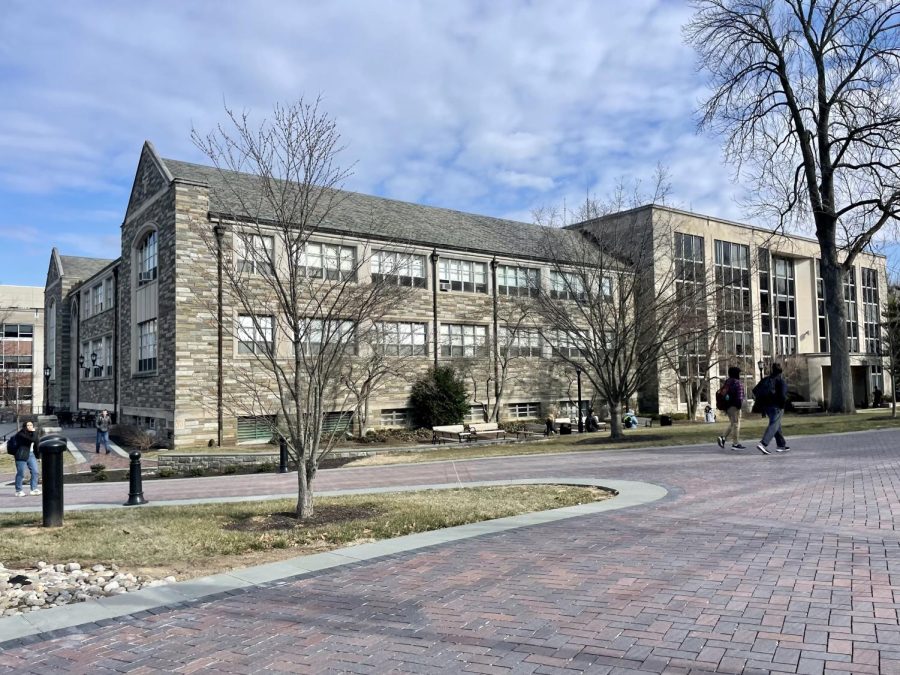Author Tsering Yangzon Lama Comes to Villanova
March 22, 2023
On March 16th, author and activist Tsering Yangzom Lama visited Villanova to discuss and read her debut novel, We Measure the Earth with our Bodies. Lama’s novel was listed as a New York Times Summer Reads Pick, won the 2023 GLCA New Writers Award for Fiction and was a finalist for the Scotiabank Giller Prize. She received her MFA in Writing from Columbia University.
The English Department and its class “Authors On and Off the Page” hosted Lama as part of their Literary Festival Series. In the class, students have the opportunity to read the works of visiting authors before meeting them. Villanova seniors Harry Wasnak and Casey Conniff introduced Lama at the event.
Wasnak and Conniff educated the audience on Lama’s background. She was born in Nepal as a Tibetan refugee, and her family has spent time in a refugee camp on the border. Lama’s novel tells the story of Tibetan families, exploring the topics of immigration and exile.
“[Lama’s novel] explores the spaces in between citizenship, homecoming and belonging,” Conniff said.
“I was invited [to Villanova] over a year ago when I didn’t know anybody would care,” Lama said, before reading a bit of her novel. “Special thanks to Villanova for that.”
The first passage Lama read was the beginning of her novel, which begins with the invasion of Tibet.
“When I think of the modern story of Tibet, it does begin with the loss of our country,” she told the audience.
An important character in Lama’s novel is a female oracle, and Lama acknowledged the inaccurate perceptions of these ancient Tibetan traditions.
“[Many view] these things [as] considered backward, superstitious and inferior [but in modernity, those traditions have] saved communities for centuries, if not millennia,” she said. “[These people were] the original ecologists or environmentalists. [Their work] is about a connection to the divine through the land.”
During the Q&A, Lama spoke of the importance of oral storytelling, and how it is not inferior to the written word.
“In the literary space, we privilege written word and think that’s the beginning of storytelling,” she said. “Oral storytelling is universal and old, and everyone knows how to do it. You need a lot of privilege to write a novel. That’s not a privilege many Tibetans have.
“Tibetans are very powerful storytellers. My mother is not a fluent reader, but she is always telling me stories.”
Recognizing the necessity of storytelling, Lama is a Storytelling Advisor at Greenpeace International, an organization that prioritizes a “green and peaceful future.”
Lama explained the presence of the “nameless saint” in her novel and its purpose. She spoke of the destruction of colonialism on objects and people.
“Objects lose their stories as the result of colonialism,” she said “A lot of Tibetans are like that. They have created their own names and pick their own birthdays.”
Lama was also inspired by a real statue she saw in the Rubin Museum of Art in New York City.
“[The statue] was a small mudstone statue that looked different from the gold-plated ones,” Lama said. “It had a very peculiar expression that looked very human. It looked pained and complex, very open to interpretation.”
When asked about the novel’s reception in Tibetan communities, Lama told the audience how the most important thing for her was that Tibetans would recognize her characters and feel truth in them. She explained that her relationship with the land of Tibet is “one of absence.”
“I’ve met many Tibetans younger than me that are determined to be novelists, which is so important,” Lama said, explaining the positive impact of her work.
The event ended with Lama detailing her long process of writing her novel and getting it published. The novel took eight years to write, and more years were spent in the revision and editing process.
However, Lama wanted to remind students in the audience that there are people around them to help with the process.
“A lot of it was alone and a lot of it was in the dark,” she said. “I would seek out help whenever I could. It’s important to remember the community was out there.”


